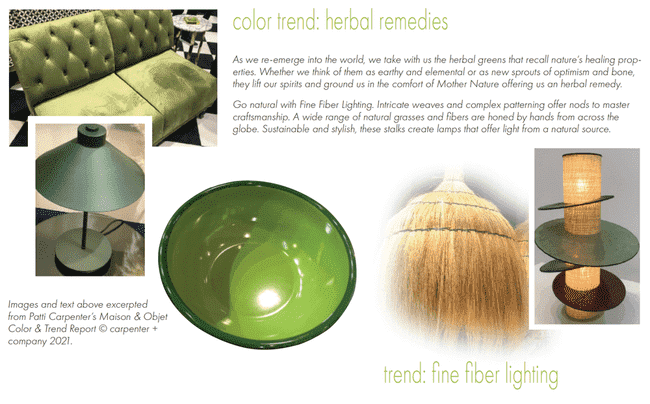INTERVIEW WITH PATTI CARPENTER
Product developer and
trend analyst Patti Carpenter provides insight into color and retail
trends. She also explores ways retailers can better connect to the value
systems of consumers.
The daughter of a graphic designer and a writer, Patti Carpenter is a
self-proclaimed non-linear thinker and artist. The well-known founder of
carpenter + company/Trendscope, she is sought after for her expertise as a
trend consultant and creative director in the globally sourced home
décor, personal accessories, fragrance and gift industries.
Carpenter’s passion for taking a trend or theme and making it right
for consumers has led her to collaborations with top brands including
Bloomingdale’s, SFERRA, Neiman Marcus, Crate & Barrel, The
Phillips Collection, abc carpet and home, Urban Zen and Ralph Lauren.
Her Career in Fashion
Growing up in Washington, D.C., she studied fine art then earned degrees in
fashion design and fashion illustration from the Fashion Institute of
Technology. “FIT brought me to New York where I made a decision to go
into fashion design. Following graduation I spent 27 years moving up through
the ranks working with wonderful people like Ralph Lauren, Oscar De La
Renta, Bill Blass and Adrian Vittadini. Also, with retailers like Timberland
and The Limited Corporation.”
Our modern world becomes better when there is a balance of home furnishings
made by modern technology and by artisans. Without that balance, we will
continue to lose cultural diversity.
In 2000, as a VP at Ralph Lauren, Carpenter decided to change her career
direction. “I could see,” she recalled, “that the industry
had taken a turn toward fast fashion, becoming more about the numbers than
about design.
“I spent a lot of time in Asia opening and working with factories
doing product development. As a creative person, I could see that it
wasn’t something I was going to enjoy going forward. Instead of
showing up at meetings with swatches of fabulous fabrics or inspiring
observations about a great art show, we spoke about margins.”
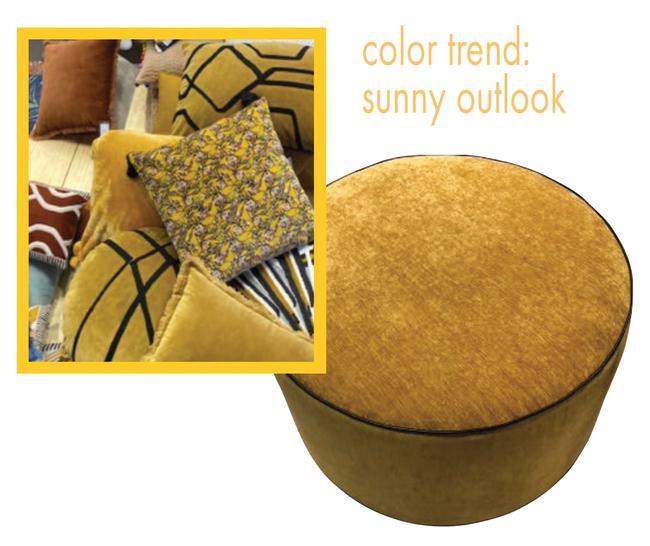
Yellows continue as we seek that Sunny Outlook. This toasted tone has
a hint of nostalgia and when used on accent pieces offers up a sense
of optimism and conviviality. Use this warmed yellow to let the
sunshine in!
Images and text above excerpted from Patti Carpenter’s
Maison & Objet Color & Trend Report ©
carpenter + company 2021.
Passion for Artisan Development
From 1995 through 2000, Carpenter volunteered to be part of the Designer
Round Table at Aid to Artisans, one of the first nonprofits to work with
artisan development around the globe. “In 2000, Aid to Artisans
offered me the right of first refusal to head up a three-year project in
Mali. It required me to spend time in northwestern Africa working to develop
products for export. I worked with individuals, families and whole villages
to understand costing and pricing, raw material procurement, lead times and
even weather patterns that might affect production. Here at home, the focus
was on collaboration with importers to develop products based on color and
trend themes, artisan capabilities and production capacity.
“I left my full-time job at Ralph Lauren and never looked back.
It’s been 20 years since starting my own business doing artisan
development. Twenty-five years later I’m still working with Aid to
Artisans, other NGOs and nonprofits in the state department, USAID.
“Working on these types of projects resonates with my artisan heart
and soul. Our modern world becomes better when there is a balance of home
furnishings made by modern technology and by artisans. Without that balance,
we will continue to lose cultural diversity. This is the story I’ve
heard everywhere from Africa to South America. Young people will work at a
Hilton rather than learning how to weave beautiful sustainable items, blow
glass or carve wood like their grandmoms did if they can’t make a
decent living.”
Carpenter lamented that the loss of artisan skills mirrors what’s
happening in the broader furniture industry as well as in nature. “If
we don’t support these people, artisan culture will be lost in a
generation. Their current situation is part of the whole sustainability
crisis but on a human level.”
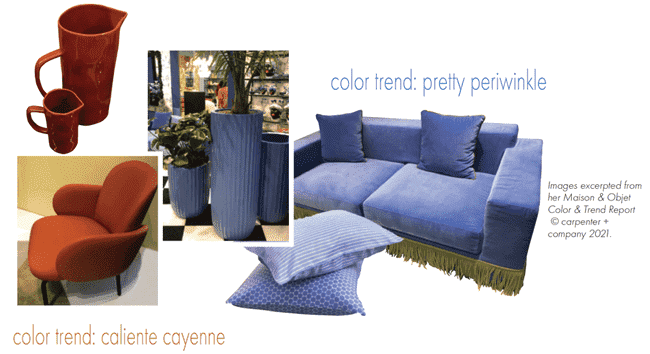
As the orange family of colors heats up and merges with the warm
neutrals that have been on the rise, they collide in Caliente Cayenne.
This scorching hot hue speaks of the passion that we are all feeling
as we re-emerge and reconnect for a brighter future. ahead.
This lovely midtone sits beautifully balanced between red and blue. As
lavender is used to calm us, this colorful hue invites us to breathe
and begin again. Pretty Periwinkle’s bluer cast resonates with
all the positive attributes of that shade while transforming us to
prepare for the newness that lies.
Segueing to more practical considerations for Furniture World readers she
offered her view that “Seeking out, supporting and merchandising items
sourced from artisans is a wonderful way for furniture retailers to tell
stories that connect with their customers. It’s an especially
effective path to take because it connects in multiple ways with
today’s consumers who are focused on doing business with companies
that are in line with their value systems. Topics like respect for the
planet and support for artisans in the retail conversation his touchpoints
that bring customers into stores and keep them coming back.”
Data &. Design Together
Furniture World asked Carpenter if her product development and consulting
work starts with an analysis of demographic, economic, political and
lifestyle trends.
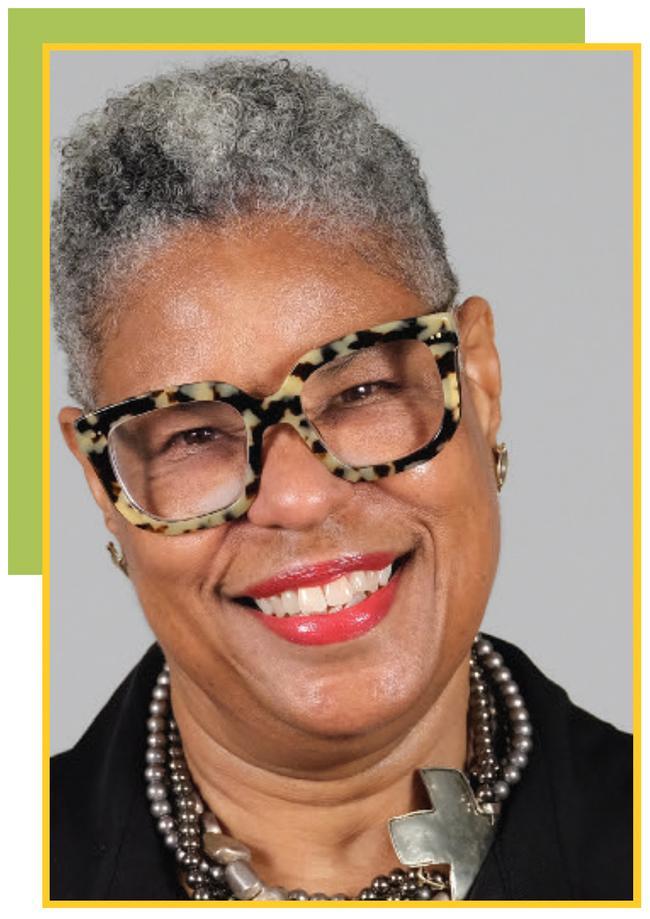 Patti Carpenter has worked with top brands including
Bloomingdale’s, SFERRA, Neiman Marcus, Crate & Barrel, The
Phillips Collection, abc carpet and home, Urban Zen and Ralph Lauren.
Photo by Marlon Cantillan.
Patti Carpenter has worked with top brands including
Bloomingdale’s, SFERRA, Neiman Marcus, Crate & Barrel, The
Phillips Collection, abc carpet and home, Urban Zen and Ralph Lauren.
Photo by Marlon Cantillan.
“Data has become a driving force in business,” she replied.
“However, my approach is more creative. I’m experienced enough
to walk a trade show or retail sales floor and pick up on the connectors
pointing to something that is going to be or already is a trend. It’s
this ability that was responsible for propelling me forward in the fashion
industry. I’ve been told that I have a great eye for color. And,
I’ve always been able to speak the language of color in a way that
people who might not have a creative bent can understand and become engaged.
“But what I really like to do is compare and contrast what’s
happening on the business side with the creative side then bring those two
elements together. Design and merchandising cannot exist in isolation. On
the creative side I also walk the line between what we see coming and
what’s selling now,” she observed. “Part of my job is to
find a way to develop choices that nudge customers forward. That’s
something I focus on in my color and trend reports.”
2022: RETAIL PLANNING
When asked what areas home furnishing brands and retailers should focus on
in 2022, Carpenter suggested that “They need to focus more on
listening to and understanding how their customers use the items they sell.
That includes finding out why customers need an item, what they will do with
it, who will be living with it and why.”
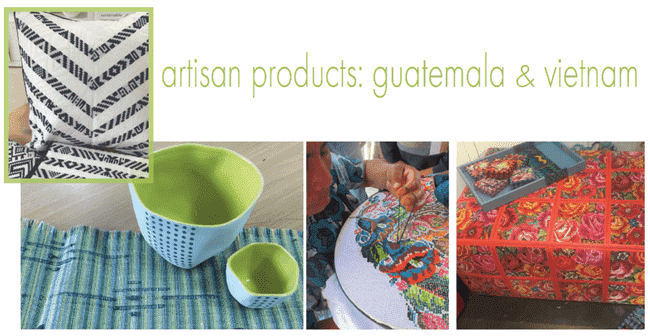
Carpenter consulted with Casa Sagrada to envision the use of
artisan-made Mayan textiles. Traditionally worn by indigenous women in
Guatemala, these textiles are incorporated into carpets and seating.
Pictured above left are artisan silk, ceramic creations and cotton
jacquard pillows from Patti Carpenter’s Vietnam collaborations.
She explained that the need for this heightened attention results from
changes in consumer purchase motivations. “There was a time when
consumers bought just about everything. That period was followed by a period
of experiential buying. Now we’re entering a phase where emotional
engagement is important,” she observed. “People have been at
home a long time and are thinking more critically about everything they
bring into their homes. They’ve discarded a throwaway fast fashion
mentality in favor of quality manufacturing, materials and textures. If you
think back just a couple of years, millennials had no use for anything
vintage or antique. Now they are driving that bus. They have a whole new
appreciation for quality and longevity. It’s something that furniture
retailers can tap into.
“Luxury brands, in particular, have had trouble adjusting the new
focus on emotional engagement that replaced a desire to possess luxury goods
or live a luxury lifestyle. That’s not enough now. Even people who can
afford such a lifestyle want to find objects that resonate with them
personally. Everything we as an industry sell sparks an emotional connection
in our customers. This connection can result from an object’s
aesthetic, the experience it promises or the way it functions. Understanding
how company values align with customers’ values is becoming much more
important.”
2022: Market Differentiation
Continuing with the subject of topics Furniture World readers might address
in 2022, Carpenter brought up issues related to competitive advantage.
“Retailers need to revisit what sets them apart from competitors and
ask the question, ‘why would shoppers come to us versus another
retailer?’
People have been at home a long time and are thinking more critically
about everything they bring into their homes. They’ve discarded a
throwaway fast fashion mentality in favor of quality manufacturing,
materials and textures.
“To do this, they must create their own stories, step into their
authenticity, understand who they are as a company and where the points of
differentiation lie.
“Second, they must establish the foundation of everything they do
going forward. Only after they plant this flag, can they define their
business universe and pinpoint the heart of what they do well.
“With this knowledge, they can ask what their product selection should
look like. The Pottery Barn consumer is not the West Elm consumer. CB2 is
not the same as Crate & Barrel. Each of these retailers has a unique
reason for being and is successful.” Carpenter said that examining
points of differentiation is not just a useful exercise for top-100
retailers. “The opportunity for differentiation is that any retailer
can become a unique destination,” she advised. “Customers
won’t only show up to replace a worn sofa, but also to find something
new and exciting. It’s a similar situation to what happened in the
clothing industry. The big department stores consolidated then struggled
because they all started to look the same. When retailers all start looking
the same it becomes a race to the bottom. Becoming unique allows home
furnishings retailers to bring more to the table. When they figure this out,
they can initiate a dialogue about what the products they sell are really
worth.”
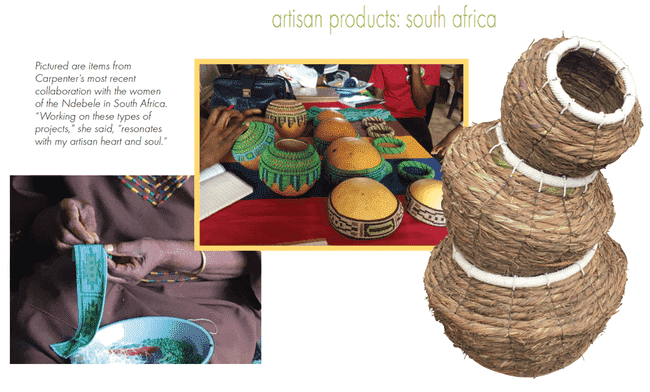
Be on the Lookout for These 2022 Retail Trends
“Across the board trends that were on the cusp of happening were
accelerated by the pandemic,” Patti Carpenter told Furniture World.
-
”We’ve seen cozy materials, more curvilinear furniture
that’s comforting and gives people a hug. There have been more
rounded edges, arches, capsule shapes, circles and spheres as well as
curvaceous sofas and seating.”
-
“There’s the trend toward grandmillennial style that uses
older things as well as cottagecore style. We’ve been talking
about cottagecore since 2017. Since then, because of COVID, this
aesthetic that reflects a kinder, gentler life, baking, riding bikes,
planting, free form and freestyle, has become more important. It’s
a bit nostalgic and informal. More like a meadow than a formal English
garden.”
-
”The demand for larger scale seating and sectionals has increased
so that people can sit farther apart. This trend first appeared in the
hospitality sector, but has now expanded into residential.”
-
”There is a focus on wood in its natural state with the grain
showing through in a mid-range of colors; walnut or cherry finishes at
the dark end as well as lighter woods in natural finishes. Wood stories
have become more important. Is it recycled, reclaimed, upcycled or
sustainably harvested? Sustainability continues to be important.
Greenwashing is still with us. It’s sad that when a consumer sees
the word sustainable, green or eco, it often doesn’t mean very
much, but organizations like the Sustainable Furnishings Council are
working on that issue.”
-
Stone used in home furnishings has become more colorful. We moved on
from white, black and grey marbles to brown a few seasons ago. Stone has
shifted now to all levels of green. Green as a family of color is
probably the most important color right now.”
-
”Look for rough-hewn and rustic weaves in natural materials with a
handwoven, tactile effect.”
-
“We are seeing spots on ceramics that look handmade so that no two
feel like they’re the same. Enameled accessories, metal and mixed
materials are important. Alabaster is a big trend as is the continued
popularity of raw edges.”
-
“Japandi is trending with its mixture of Scandinavian and Japanese
for a minimalist and serene effect. This is in reaction to years of
extraneous, unnecessary products just piled on for maximalist effect.
It’s now really cleaning up, with a trend toward items with an
aesthetic that can be simple, beautiful, useful and mobile to
reconfigure when necessary.”
-
“We’re certainly seeing beautiful trends in lighting. LEDs
have expanded lighting’s design possibilities. The category has
become much more interesting and artful. Retailers should be looking at
a new generation of LED lighting innovations especially if they have an
industrial feel.”
-
“Bringing the outside in has never been a stronger trend. In the
70s many people owned indoor trees such as a Ficus. Now we are seeing
the move from smaller plants in the window to larger scale,
decor-inspired planters with large trees for the inside. Additionally,
there are many products and objects in the marketplace that are inspired
by nature, but not necessarily constructed in the same materials as the
original inspiration. These include prints and patterns on furniture and
functional accessories in the shapes and silhouettes of plants, leaves,
and flowers.”
-
Multi-generational spaces are on the rise in the U.S. During COVID
we’ve seen the idea of multi-sharing spaces and a corresponding
need for spaces and furniture that are multi-functional.”
Becoming unique allows home furnishings retailers to bring more to the
table. When they figure this out, they can initiate a dialogue about what
the products they sell are really worth.
